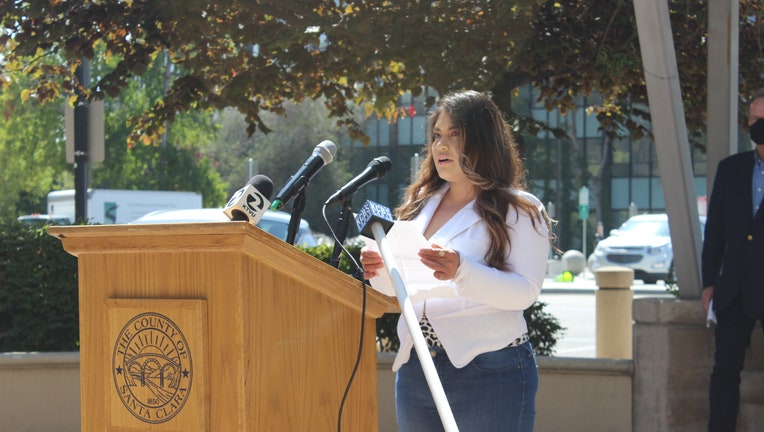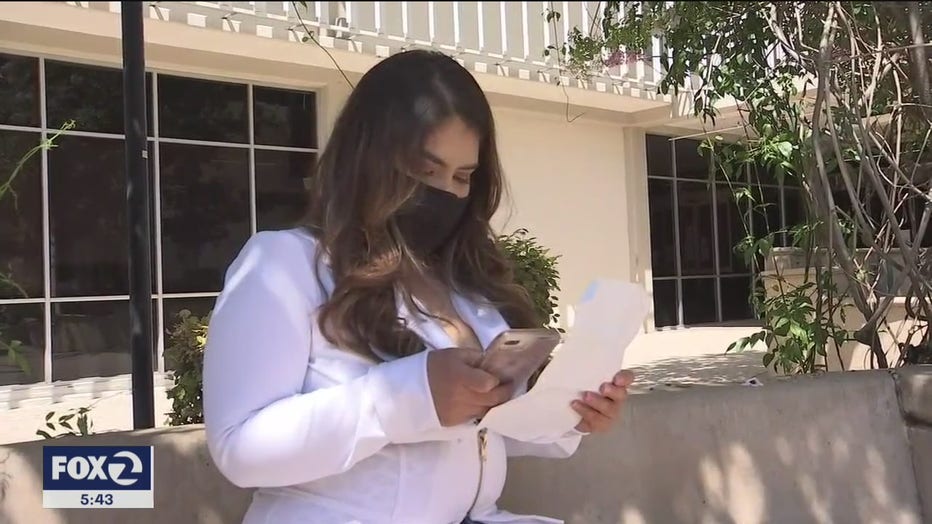Santa Clara Co. rolls out universal basic income program for youth transitioning out of foster care

Nayeli Grano. Photo by Jana Kadah.

Santa Clara Co. rolls out universal basic income program for youth transitioning out of foster care
Santa Clara County has rolled out the country's first Universal Basic Income program for young adults transitioning out of foster care.
SAN JOSE, Calif. - Santa Clara County has rolled out the country's first Universal
Basic Income program for young adults transitioning out of foster care.
The program, approved last month by the Board of Supervisors,
provides a monthly stipend of $1,000 for a year to former foster youth ages 24 and over who are too old to receive foster assistance.
"I am going to be turning 25 soon and my efforts right now are
getting ready for that year that I am not going to have a stipend anymore," said Nayeli Grano, former foster youth and foster youth advocate. "That doesn't change with UBI, but it helps me breathe a little. It helps me know and not stress about having money to pay for rent."
Grano was not one of the 72 young adults chosen to receive the
monthly stipend because she is still 23 years old. The participants were prioritized by age, as older former foster youth are more in need of the assistance, said Sandhya Hermon from the Santa Clara County Social Services Agency.

Supervisor Dave Cortese. Photo by Jana Kadah.
"When we were first designing this study, we wanted to include
youth who were over 21 and under 25 because that is the age range that support typically tapers off," Hermon said. "Given that we couldn't include all those youth, which is about 190 youth, we prioritized by focusing on the oldest 72."
Foster youth stop receiving assistance from the county at 25, but
the problems don't cease to exist, according to Grano.
"When you turn 25 you are alone, no one is helping you. You have
to work for everything ... All of a sudden you lost your job, and you can't pay for rent, who are you going to go to? Your family. A lot of foster youth don't have that," Grano said.

Grano said knowing this assistance may be available for her in the
next couple of years makes her dreams much more tangible. She is planning on attending either University of California at Berkeley or UC Santa Cruz to get her bachelor's degree and become a probation officer to help other foster youth.
Eventually she wants to get a law degree so she can continue to
advocate for foster youth and "make policies like this.
Supervisor Dave Cortese spearheaded the initiative after meeting
with local philanthropist Gisele Huff, who is also the president of the non-profit organization The Gerald Huff Fund for Humanity.
Huff's organization promotes the idea of UBI as a form of
investment in society. Both Cortese and Huff found it essential to do the trial of UBI for what they believe to be one of the most vulnerable communities in the county.
"Providing UBI to Santa Clara County's transitioning foster kids
is literally a lifeline for that at this devastating time," Huff said. "It
opens the floor to making it available to all marginalized people who desperately need a floor to stand on."
The program was approved for $900,000 in funding from the county's general fund and will be used for monthly stipends as well as an in-depth evaluation of the pilot program. The evaluation will determine how the program continues in the future, however Cortese said it would be incredibly unlikely to see the board cutting the program.
The program will also be supported by MyPath and Excite Credit
Union, which will provide financial education and mentoring for people in the program.
"A lot of times they [foster youth] have to learn through trial
and error and by mentoring them it will hopefully limit the errors they make in the future," said Aleta Smith, a former foster youth and community relations specialist from Excite Credit Union.
"Foster youth struggled before the pandemic just meeting basic needs. Now with the pandemic, things have just been amplified so this really could not have come at a better time."
A study by the county found that Black and Latinx children are
overrepresented in the foster care system. Latinx children make up nearly 36 percent of the county's general population aged 0-17 but make up 70 percent of the welfare population. Black children are only 2 percent of the county's youth population but make up 8.5 percent of the welfare system.
"There is over representation of people of color and why is that?"
Cortese said. "Clearly they have been disadvantaged from the start by a system that is sort of rigged against them, not only because they are foster youth but to have the double whammy of being young people of color who may have experienced some tracking in schools, some discrimination and systemic bias in schools that push them into less rigorous pathways than other kids."
Cortese said foster youth are also overrepresented in the school
dropout rate, in mental health issues, in homelessness issues and in drug and alcohol addiction issues relative to young people their same age.
"This is a way to make amends for that, not as a charity, but to
try to compensate for some of the setbacks they have experienced along the way," Cortese said. "These are kids who have done nothing wrong, have managed through the system at this point and are basically the children of the county so we are the surrogate parents, we have the responsibility."

